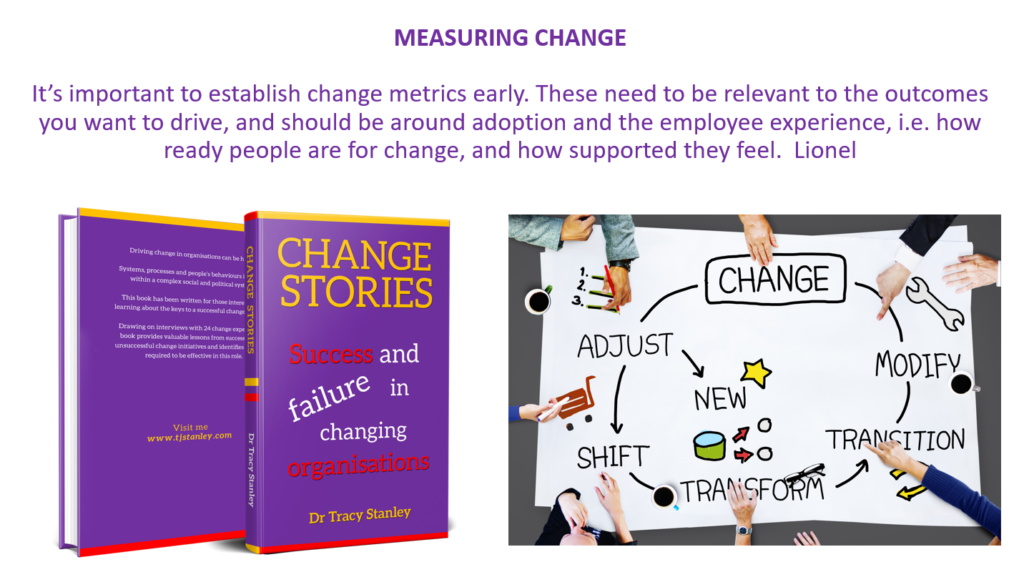Why measurement matters in change management
If you want to change something, measuring the rate of a change from where you are to where you want to be, not only tracks your progress but helps you to evaluate the effectiveness of the actions that you’re taking to achieve the desired outcome. Some things are easy to measure but aren’t necessarily great indicators of behavior change. For example, it’s easy to measure attendance on a training course, but harder to measure the extent to which the skills have been acquired and continue to be applied correctly over time. Every change manager needs to assess what should be measured, when’s the best time to do this and what’s the impact of the measurement. Too much measurement or inconvenient timing can fatigue the person providing the evaluation.

In my book of Change Stories: Success and failure in changing organisations, I asked all those I interviewed how they measured the effectiveness of their change programs. Here are a few of the examples they provided.
Measuring changes to safety culture
We had a few different measures. One was conducting a safety culture assessment, prior to actually commencing the engagement and then again at the end. We assessed individuals’ attitudes to safety, and looked equally at anecdotal feedback that came from leaders around what they could see changing within the organisation.
There were lots of good news stories where people mentioned somebody who had been quite resistant, and all of a sudden, there was this, almost like a switch had gone off and they had completely shifted and started to become more engaged in becoming more of an advocate, in terms of working safely.
We undertook regular surveys and had a high completion rate – which is also a sign that the project is going well. We combined surveys with face-to-face consultation. Fiona
No negative pushback in the media and talent retained
We delivered it within the timeframe that needed to be delivered. Funding was secured. We demonstrated that the changes were in place. We retained the talent that we had identified as needing to be retained and we didn’t get any negative pushback in the media. We were able to sit at the executive table with the sponsors who said, ‘You guys equip us’. They said yes when we needed to send out a letter with their signature. Samantha
Reporting on change readiness and change challenges
It’s important to establish change metrics early. These need to be relevant to the outcomes you want to drive, and should be around adoption and the employee experience, i.e., how ready people are for change, and how supported they feel. These metrics are very different than the usual project metrics of on-time or on-budget delivery. It’s about ensuring the right metrics are in place to measure that people are adopting new ways of working, embracing new technology and effectively performing as a result of the change, and ultimately the organisation is realising the benefits and outcomes they set out to achieve.
We work with the business to establish and track these metrics through reporting to the senior leadership team. As a change manager, how you influence in that space is important. Otherwise, how do they define the success of a project? Is it about delivering on time or is it about people using new technologies or adopting change and not reverting back to old ways of working? It’s that benefits realisation piece. Some questions that you can explore with the appropriate leaders and stakeholders include:
- What’s the impact of this change?
- Does it impact the whole organisation, or does it hit across a small part of the organisation?
- How many people? The entire organisation, a few divisions, or one team?
- What are the change risks associated with it?
- What is the change leadership capability of the people leading it?
- How will we know we are successful? What will people be doing differently? Leanne

So a range of business, project and behavioural measures can be identified and tracked to enable the impact and effectiveness of a change initiative to be demonstrated. These stakeholder measures could include qualitative information such as anecdotal feedback, and quantitative data such as user adoption, while business measures could relate to revenue or business growth.
You can learn more about measurement the keys to success in organisational change programs in my book, Change Stories: Success and failure in changing organisations.